
Mycenae
Mycenae / Μυκήναι
Mycenae, or Μυκήναι in Greek, was first settled by Neolithic people in the 6th millennium BC. It's hard to distinguish history from myth in Mycenae. According to Homer, the city was founded by Perseus, the son of Danae and Zeus. The dynasty of Perseus was eventually overthrown by Pelops, a son of Tanalus.
The real Mycenaean Royal House of Atreus was probably descended from this Pelops, although it's hard to tell what was mythical as opposed to merely mythic. But somewhere around the 14th Century BC, there seems to have been a King Agamemnon of Mycenae.
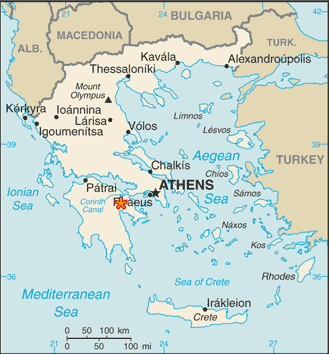
Map of Greece showing the ancient site of Mycenae.
History
Between about 2100 and 1900 BC, during the Old Bronze Age, Indo-European people crossed Anatolia, moved through Troy, and continued across the Dardanelles to the west and then south through the peninsula we now call Greece.
The existing settlements in the mainland were primitive, and these new arrivals brought an advanced culture. A number of small kingdoms were established. In addition to the one at Mycenae, there were kingdoms in nearby Tiryns, Pylos, Argos, and Korinthos.
The kingdom of Mycenae became the most powerful by far, leading to Mycenaean becoming the term for the entire civilization of that area and time. It had contacts of trade and culture with the advanced civilization on Crete. For the 400 years from 1600 to 1200 BC, Mycenae was the most powerful kingdom in Greece.
Crete and the ancient settlement of Knossos were also part of the Mycenaean world. The Mycenaean culture also influenced settlements throughout the Aegean, in Epirus and Macedonia, along the coast of Asia Minor and down to the Levant, on the large island of Cyprus, and in the Italian peninsula.
Mycenaean power began to decline around 1200 BC. Its palace was burned around 1100 BC. It's not known if this was caused by an attack from outside Greece, or if it was warfare within the many Mycenaean kingdoms.
Its hilltop site is barren today, lying below Mount Agios Ilias (750m) and Mount Zara (600m) and overlooking the plains leading to the Gulf of Nafplio.
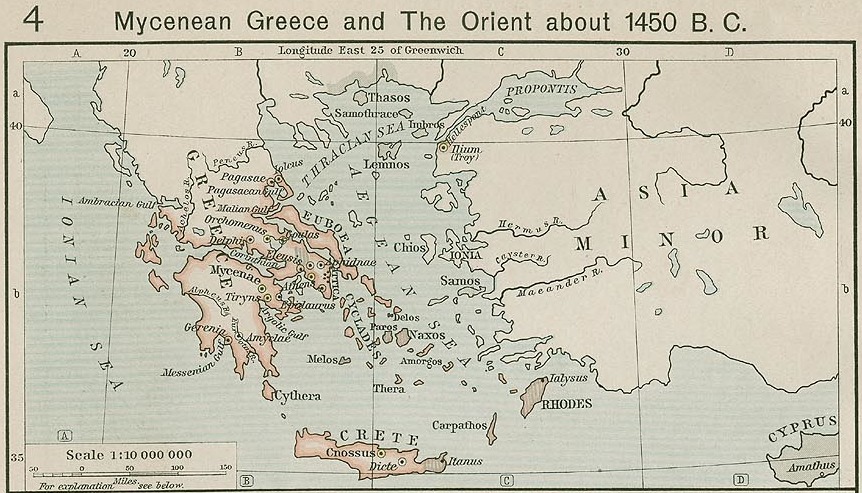
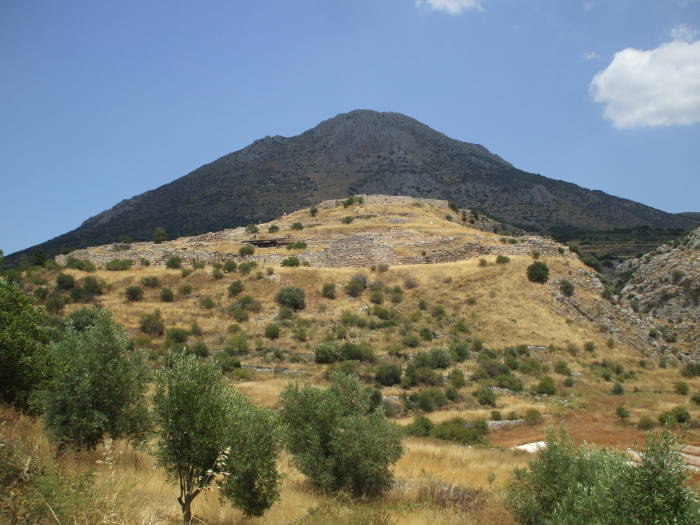
The ancient site of Mycenae below Mount Agios Ilias (750m) and Mount Zara (600m).
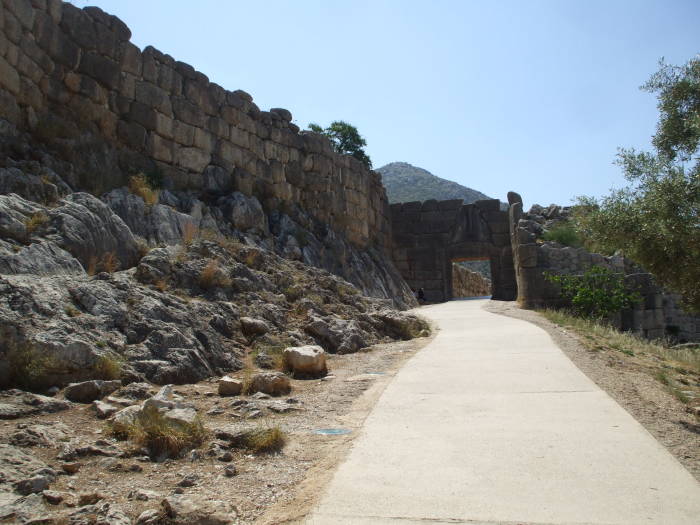
Pathway leading to the main entrance to the citadel of Mycenae.
Amazon
ASIN: 0226470490
Agamemnon (or Άγαμέμνων) is said to be the son of King Atreus and Queen Aerope of Mycenae. Agamemnon's brother was Menelaus.
Menelaus' wife Helen was abducted by Paris of Troy and taken back to his city on the northwest coast of Anatolia. Agamemnon then commanded the Achaean forces (what we often mis-label as "Greek" today) in the Trojan War.
When Agamemnon returned home from the Trojan War, his wife, Clytemnestra, had taken a lover, Aegisthus. Agamemnon and his concubine, Cassandra, were killed by Aegisthus, or by Clytemnestra, or by the both of them, depending on which version you read.
Schliemann's Excavations
Skipping ahead to the 1800s AD, Heinrich Schliemann was a history-obsessed businessman turned archaeologist. He believed that Homer's Illiad and Odyssey and Virgil's Aenid described real historical events. Few historians and archaeologists thought that these stories were anything more than myth.
Schliemann got involved in the excavation at the tell or mounded hill of Hissarlık, in Turkey, in 1871. Archaeology was crude in those days. Believing that Homeric Troy must be the oldest, thus the lowest, level, Schliemann and his workers dug quickly through the layers until they reached fortifications that matched his expectations of Troy.
As historians later realized, Hissarlık was Homeric Troy. Schliemann did find Troy, but he dug right through the part he was looking for.
In 1873 Schliemann found a cache of gold objects and called it "Priam's Treasure". He smuggled it out of Turkey, angering the Ottoman Empire to the point that he lost permission to dig further at Troy.
In 1876, he began excavating at Mycenae. No one questioned the existence of a significant citadel at the site. The ruins and even this main entrance had always been visible through the centuries, and the site was a tourist attraction in Classical Greek and Roman times.
But without Schliemann's enthusiastic theories, most modern historians did not consider this to be the Mycenae of Agamemnon. And given the dreadful history of this region up to the late 1800s, few had cared to investigate closely.
Given Schliemann's recent behavior in Turkey, the Greek government made sure that they had someone there to watch him. He quickly found the Shaft Graves, finding skeletons and regal gold objects. This included what he immediately named the Mask of Agamemnon, and he supposedly sent a cable to the Greek King reading:
I HAVE GAZED UPON THE FACE OF AGAMEMNON.
The Citadel of Mycenae
The main entrance gateway to the citadel of Mycenae is the famous Lion Gate, watched over by these now headless lions. The relief of the lions is the oldest monumental relief in Europe, dated to about 1240 BC and therefore from the final grand century of Mycenaean prosperity.
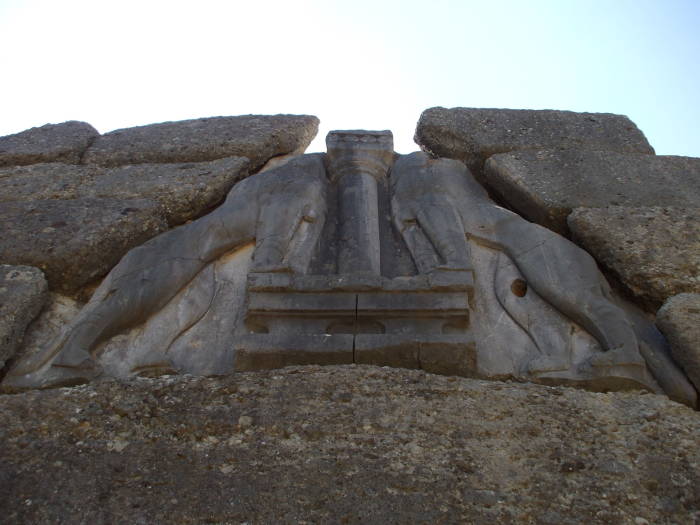
Lion Gate at the entry to the ancient site of Mycenae.
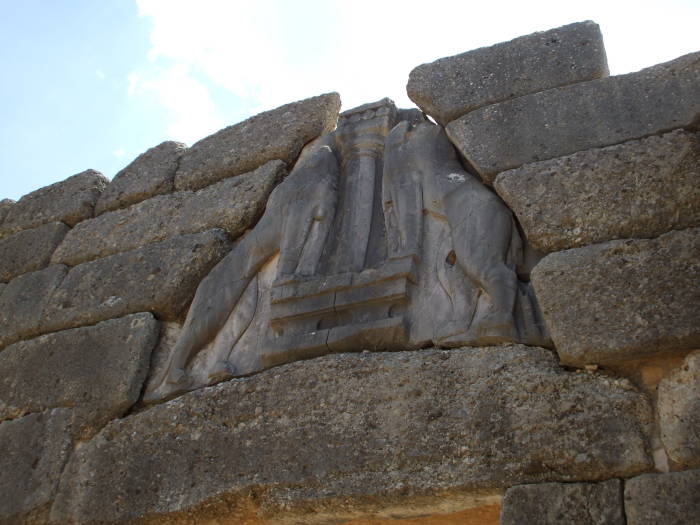
Lion Gate at the entry to the ancient site of Mycenae.
The monolithic (meaning made from a single large stone each) threshold, lintel, and gate door jambs are made of conglomerate stone, known as "almond stone". The "relieving triangle" above the lintel is masked by the lion relief.
Immediately inside the Lion Gate, to the traveler's right, is the Granery. It's named for the carbonized cereal grains found in its two surviving basement rooms. It includes two corridors and a staircase leading to at least two apartments at ground level.
A distinctive type of pottery was discovered here, representing the last phase of local artistic creation. That pottery style is known as Granery Class.
The Granery was built in the late 13th Century BC, when the walls were extended and the Lion Gate built, and destroyed in the mid 12th Century BC.
Amazon
ASIN: 184176762X
Amazon
ASIN: B00ASWOQMS
Grave Circle A spreads to the west of the citadel, forming part of an extensive cemetery of the Middle Helladic and early Late Helladic periods. It was used exclusively for royal burials during the 16th Century BC, when it lay just outside the citadel walls. It contains six shaft graves, five excavated by H. Schleimann in 1876 and one excavated by P. Stamatakis in 1877. Nine women, eight men, and two children were buried here.
Each grave was marked by stone stelae and contained especially luxurious grave goods. These include engraved and inlaid swords and daggers, spear points, and arrowheads, indicating that these were warrior chieftains and their families.
The outer wall was extended toward the west around 1250 AD, enclosing the royal burial ground within the citadel walls and adding the Lion Gate. The walls were of a style called cyclopean because of the use of massive blocks of stone, later thought to have been the work of the one-eyed giants. The grave circle was then enhanced by the construction of a circular enclosure.
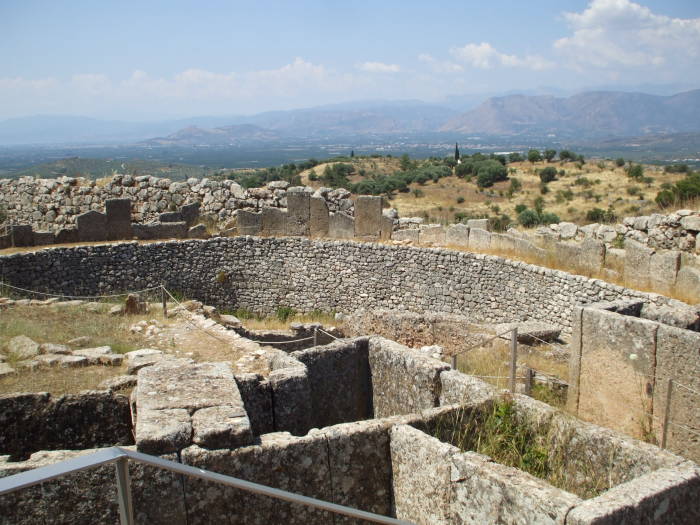
Grave Circle A

The North Quarter and the Buildings on the North Slope.
The North Quarter of Mycenae was first occupied during the Middle Helladic Period. It came under more extensive use when a large set of structures was constructed in the later 13th Century BC, These structures were of a rectangular plan, including a complex of adjacent rooms making up two separate building complexes, corridors, courtyards, and an extensive system of drains and conduits.
The area was destroyed by an earthquake and abandoned. It was then reinhabited in Hellenistic times.
The Palace Complex
The palace complex of Mycenae was built on the summit of the hill. The site was first used in the Early Helladic period of 3000-2000 BC. The ruins you see today date to the 13th Century BC.
The main part of the surviving palace complex is a large court and the megaron, made up of the columned entrance portico, the prodomos (or antechamber), and the domos or main hall, with a large raised circular hearth at its center. There would have been an opening in the roof over the hearth, with columns at its four corners. The throne stood half-way down the south wall of the domos, visible to the side as one entered.
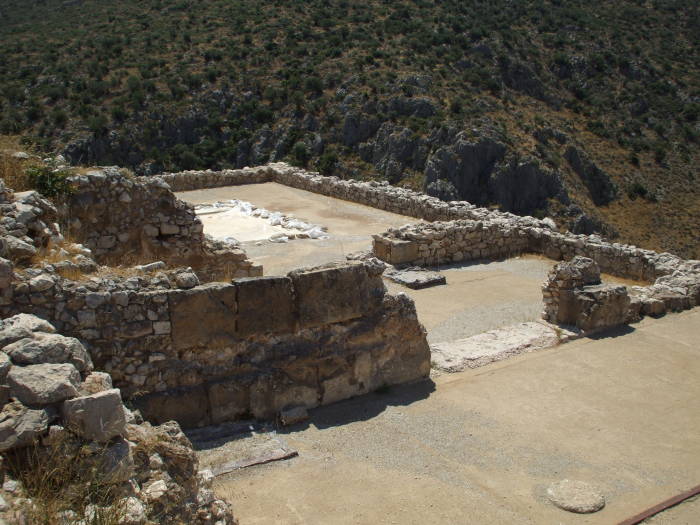
The megaron of the Mycenae palace.
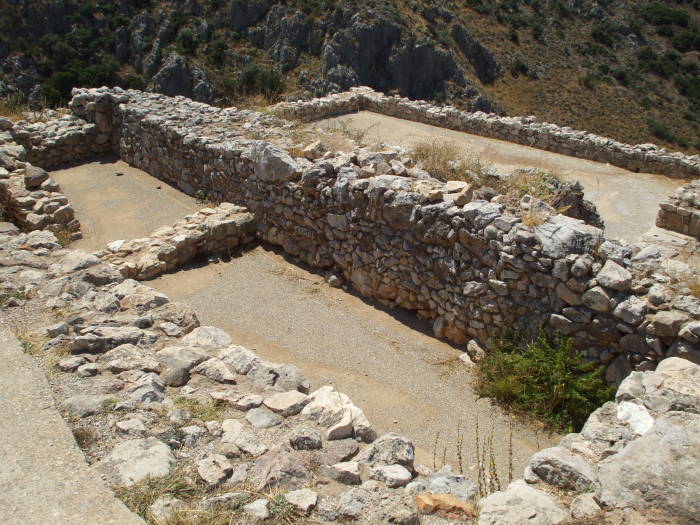
Inner chamber of the ruler at Mycenae.
The megaron was the center of power of Mycenae, the hub of the political, administrative, military, and economic spheres. The megaron was destroyed in the late 13th Century BC, possibly by fire. Part of it was rebuilt, possibly in the 12th Century BC, but by then Mycenae had lost the glory and power it had enjoyed through the previous century.
The Mycenae citadel was not deserted after the palace was destroyed. The site was inhabited continuously, as shown by the large quantities of later pottery, graves, and buildings.
The inner royal chambers were off the north side of the main hall, opposite the throne. These chambers consisted of a medium sized room and two smaller chambers at the rear.

Palace complex of Mycenae, largely from 13th Century BC.
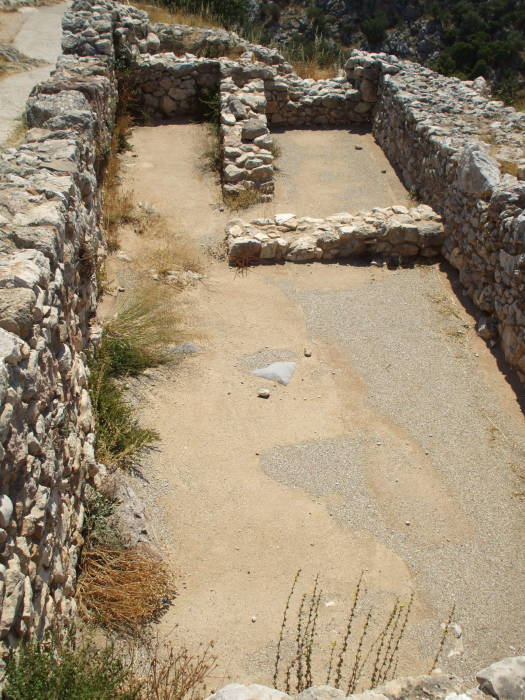
Inner chamber of the ruler at Mycenae.
Precincts of the Citadel
The fortified citadel was surrounded by estates and small villages, people living outside the walls could have sought shelter inside when threatened by invading forces. Since Mycenae was the capital of a state dominating much of the eastern Mediterranean, they surely selected this location up in the hills well away from a harbor for defensive reasons.
The citadel had concentric defenses: the outer walls, the precinct of the palace, the palace itself, and the structures within that. This was the innermost sanctum of Agamemnon, where the Mycenaean ruler would have slept.
The Artisans' Quarter was an extensive building complex in the east wing of the Palace of Mycenae. Only the foundations survive, but it had two stories as the base of a staircase remains in its northwest corner.
It had two rows of rooms on either side of a narrow courtyard entered from its north end. It has been designated as the artisans' quarter because of the art material and objects found there: unfinished ivory objects, and raw material including gold leaf and fragments of semi-precious stones. The quarter and the artifacts found there date to the late 13th Century BC, at which point the area was destroyed by the great fire around 1200 BC.
Check ferry schedules and buy tickets:
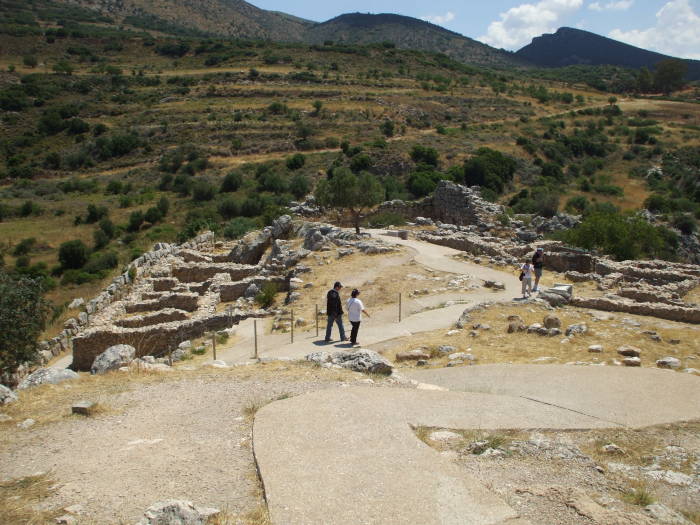
Artisan's Quarter in the east wing of the Palace of Mycenae.

The House of Columns at ancient Mycenae.
The House of Columns was the most important structure on the east slope of the citadel. Its northwest corner, the site of its main entrance, includes the remains of the doorjambs and a conglomerate threshold.
The house's name comes from the remains of a colonnade in its central courtyard.
Mycenaean Infrastructure
Some basement storerooms survive to the south of the House of Columns. Those storerooms yielded some commercial stirrup jars and a Linear B tablet. Like most of this district, it dates to the late 13th Century BC and was destroyed by the great fire of 1200 BC.
A critical part of defensive siege warfare is the maintenance of the water supply. Water is more critical then food, it's almost always the lack of water that ends a seige. But the Mycenaeans had an impressive water supply.
Mycenae had a large underground water cistern, one of their more spectacular construction achievements. The cistern itself actually laid outside the fortress walls, but it and its access were safely underground. The cistern passage begins inside the northeastern corner of the citadel, where you find the entrance to a corbelled passageway.

Entry to the tunnel leading to the underground cistern.

Tunnel leading to the underground cistern.
The tunnel passes down through and underneath the fortress walls, and continues on down toward the cistern. Eighteen meters down, after turning at two landings, you reach the large cistern in the form of a four-sided roofed shaft.
The water was collected from a natural spring well outside the fortress walls, and carried along buried clay conduits to the cistern.
The North Gate or Postern Gate was constructed around 1250 BC, during the second building phase of the walls. Four monolithic blocks of conglomerate or "almond stone" form the two door jambs, the lintel, and the threshold.
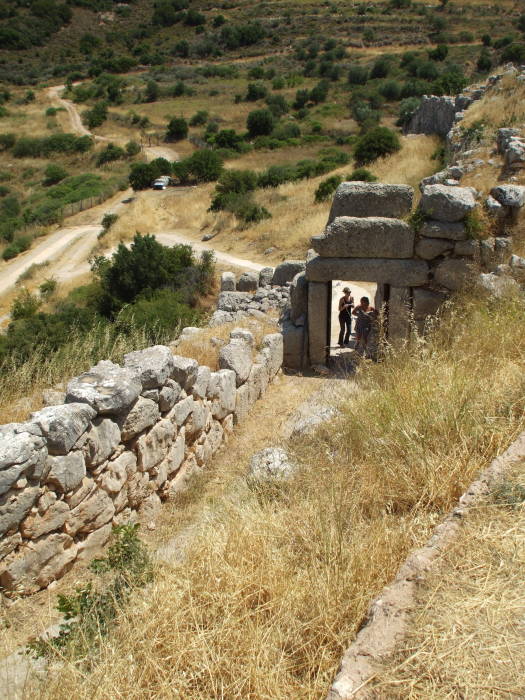
North (Postern) Gate.
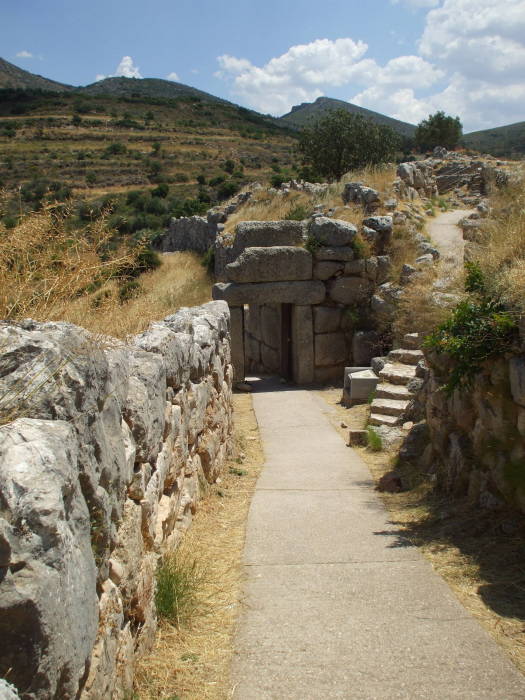
North (Postern) Gate.
It has two plain vertical slabs set on their edges above the lintel, rather than a relieving triangle, transferrering their weight to the two doorposts.
A small internal court just inside the gate is the beginning of a small road leading up to the megaron.
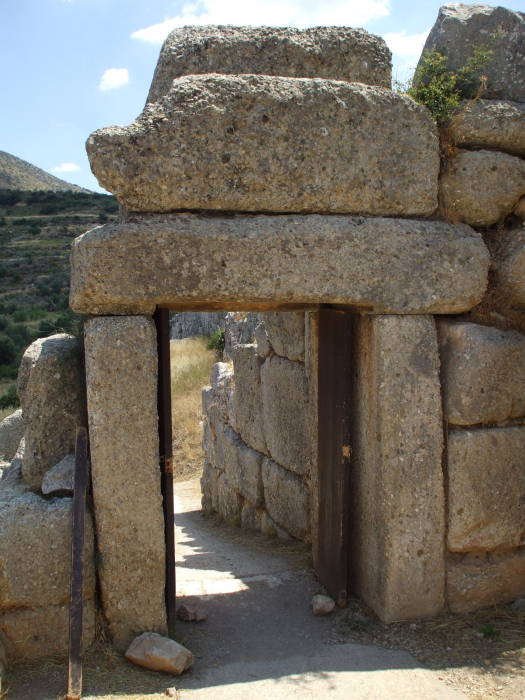
North (Postern) Gate.
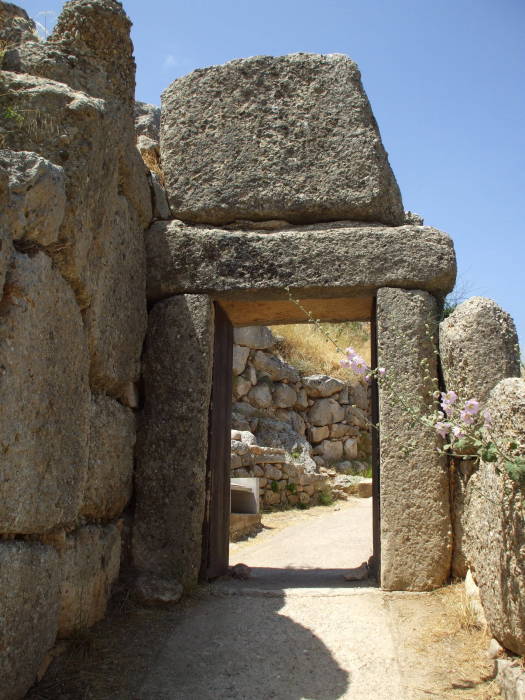
North (Postern) Gate.
The Tholos Tomb
The "Treasury of Atreus" or "Tomb of Agamemnon" was a tholos or "beehive" tomb. It was built around the middle of the 14th Century BC.
The titles are those given by Schleimann, who seemed to always find the mythic person he had in mind.
Like all the tholos tombs, it had been robbed long before it was rediscovered in modern times. There is no information about the grave goods it would have contained, or even who was buried here.
Parts of the sculpted decoration of the monumental facade are now in the National Archaeological Museum in Athens and the British Museum in London.
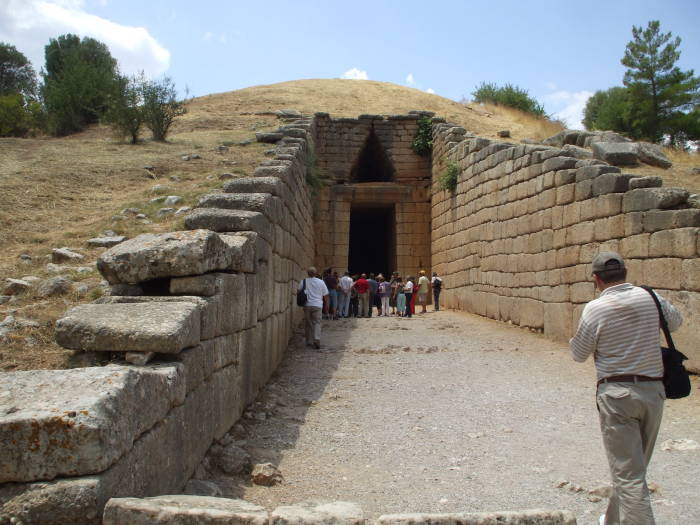
"Treasury of Atreus" or "Tomb of Agamemnon" tholos or "beehive" tomb.
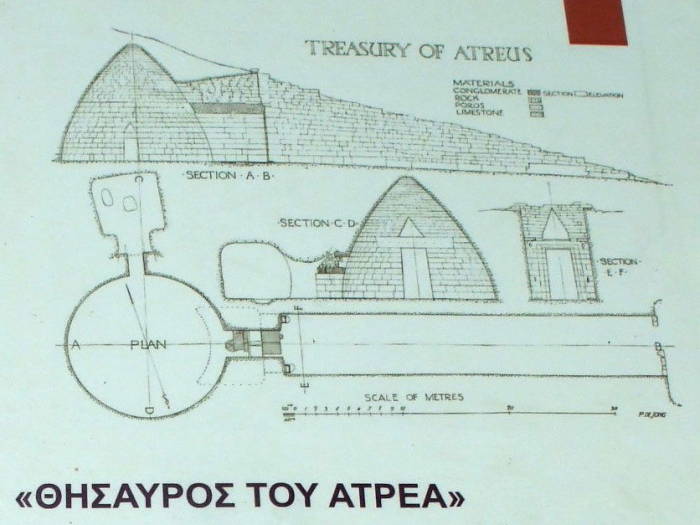
Plan of a typical tholos tomb.
Tholos tombs are built with a dromos (passage), stomion (entrance), tholos (vaulted chamber), and a small side chamber off one side of the main chamber.
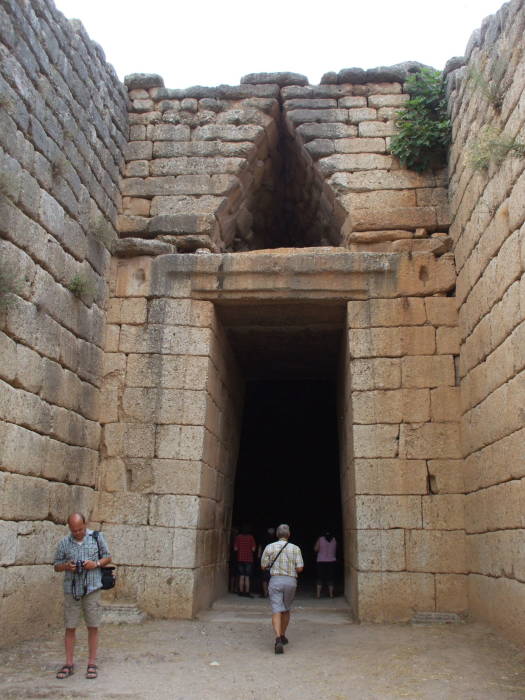
Stomion or entrance to the "Treasury of Atreus" or "Tomb of Agamemnon" tholos tomb.
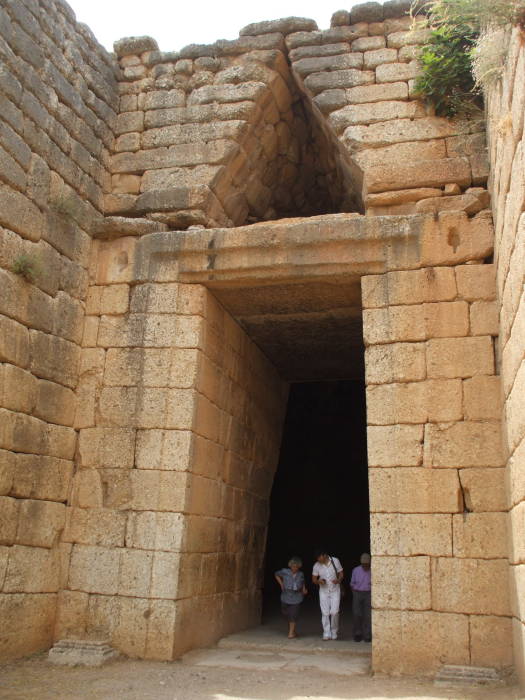
Stomion or entrance to the "Treasury of Atreus" or "Tomb of Agamemnon" tholos tomb.

"Tholos" or vaulted chamber of a Mycenaean tomb.

"Tholos" or vaulted chamber of a Mycenaean tomb.
Linear B Script
Linear B was a syllabic script used to write Mycenaean Greek, an early form of Greek. It predated the Greek alphabet by several centuries, its use ending with the fall of the Mycenaean civilization. It consists of 87 syllabic signs, and also has about 110 ideograms standing for objects or commodities. The syllabic signs have phonetic values, and could be used to write sentences. The ideograms have no phonetic values and were never used as words in sentences.
The script seems to have been limited to administrative uses. Official records, receipts, that sort of thing. A relatively small number of different "hands" have been noticed, so it appears that it was used only by a guild of professional scribes serving the central palaces.
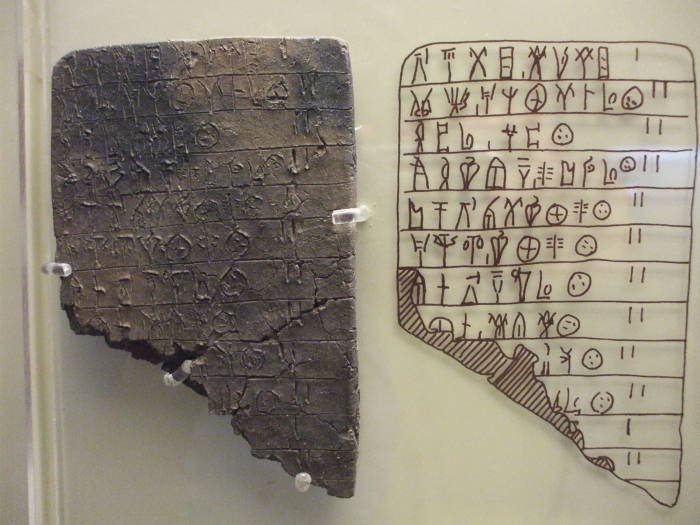
Mycenaean Linear B tablet.
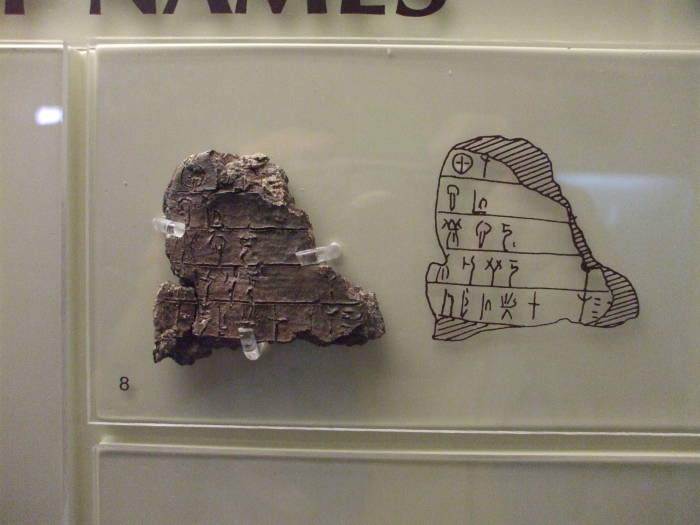
Mycenaean Linear B tablet.
Amazon
ASIN: B003MNGEOI
Amazon
ASIN: 0500289980
There are even Unicode code tables for Linear B, one for the syllabary and one for the ideograms. But I doubt that there are many web pages written entirely in Linear B.
These tablets are in the nice museum just below the citadel.

Mycenaean Linear B tablet.
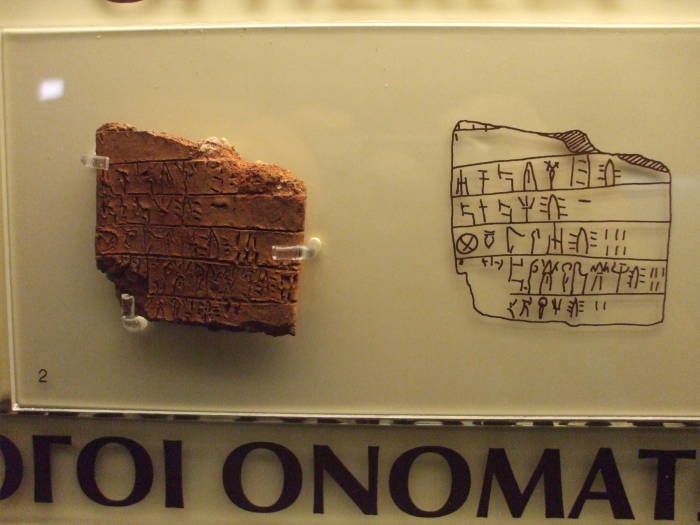
Mycenaean Linear B tablet.
Let's see if your browser can handle Linear B Unicode.
𐀀 = A
𐀁 = E
𐀂 = I
𐀃 = O
𐀄 = U
𐀅 = DA
𐀆 = DE
𐀇 = DI
𐀈 = DO
𐀉 = DU
𐀊 = JA
𐀋 = JE
𐀍 = JO
𐀎 = JU
𐀏 = KA
𐀐 = KE
𐀑 = KI
𐀒 = KO
𐀓 = KU
𐀔 = MA
𐀕 = ME
𐀖 = MI
𐀗 = MO
𐀘 = MU
𐀙 = NA
𐀚 = NE
𐀛 = NI
𐀜 = NO
𐀝 = NU
𐀞 = PA
𐀟 = PE
𐀠 = PI
𐀡 = PO
𐀢 = PU
𐀣 = QA
𐀤 = QE
𐀥 = QI
𐀦 = QO
𐀨 = RA
𐀩 = RE
𐀪 = RI
𐀫 = RO
𐀬 = RU
𐀭 = SA
𐀮 = SE
𐀯 = SI
𐀰 = SO
𐀱 = SU
𐀲 = TA
𐀳 = TE
𐀴 = TI
𐀵 = TO
𐀶 = TU
𐀷 = WA
𐀸 = WE
𐀹 = WI
𐀺 = WO
𐀼 = ZA
𐀽 = ZE
𐀿 = ZO
See the Unicode organization's PDF documents if you want
to see the full set of
Linear B Syllabary, the
Linear B Ideograms, and the
Aegean Numbers.
Logistics
Mycenae is an easy day trip out of Nafplio, and not a difficult one out of Corinthos.
Two buses run every day between Nafplio's main bus station and the entrance to the site. You will want to be on the earlier one, in order to have three or four hours at the site and still get back on a return bus.
Several buses each day run between Corinthos and Argos. They can let you off along the highway a kilometer or two from the site, and then you can flag one down for your return trip. This also provides an alternative for getting back to Nafplio.
If you're coming from further away to the north, maybe Athens, treat this as two trips. Get to Corinthos first, and then work on getting to Mycenae and back. I suppose it could be done as a day bus trip out of Athens, but then you would have to deal with the dreadful Athens bus stations. Get out of Athens once you've seen the main sites, the rest of Greece is far more pleasant!
The train makes for a much more pleasant way to reach Nafplio if you're coming down from Corinthos, Athens, or the northern shore of the Peloponnese.
I stayed at Dimitris Bekas' guesthouse. It's a great place and the main budget option in the center of town. It's at Efthimiopoulou 26. Get to the Roman Catholic church, go up the stairs to your left, take the first passageway to the right, take the first major passageway to the left. No website, and as far as I know, no e-mail. Just call him up and make a reservation:
Dimitris Bekas
Efthimiopoulou 26
Nafplio, Greece
+30-2752-024-594
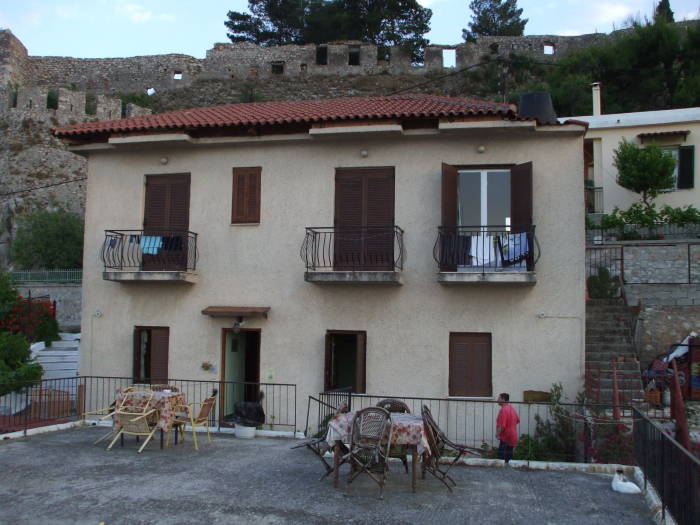
Dimitris Bekas guesthouse or domatia in Nafplio.
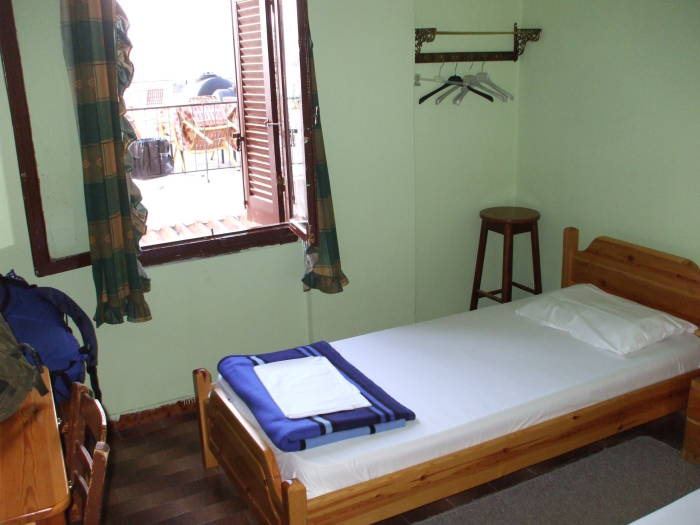
Interior of guest room.

Taking in the sunset over Nafplio harbor.
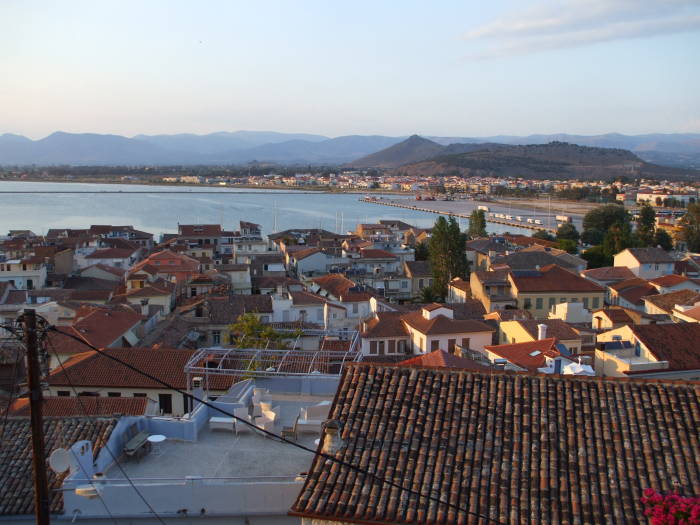
The sun sets on Nafplio.
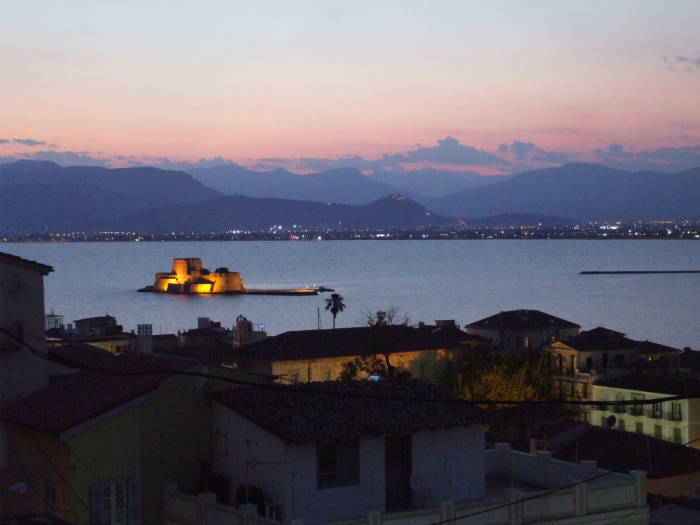
The castle of Bourtzi in the Nafplio harbor, built by the ruling Venetians in 1473.